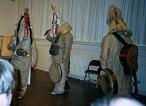"This is a Mummers’ play I wrote": Part 5 - School and Community Mumming
School and Community MummingThese plays have similarities with adapted mumming plays and skits, in that they may reflect the interests of the school or community, and may feature the topical satire of skits. The difference is that these productions are by amateurs led by professionals, meaning drama teachers, professional actors and similar facilitators. They are usually one-off performances or programmes, possibly associated with a festival or special event. Typically, they are initiated or sponsored by an educational or arts body. The motivation of these bodies is educational, whereas for the teachers and facilitators the projects may also be a livelihood. The project leaders may provide a ready-made script, perhaps from a menu of wares on offer to potential clients. More likely, the script will be composed by the group under guidance from a project leader, probably in a workshop setting, and perhaps leaving scope for improvisation during the performance. Anything goes, although the script may paraphrase or copy the style of the tradition |
School and Community Examples
|
|
 Fig.4 - The Armagh Rhymers Click on thumbnail to view full-size |
|